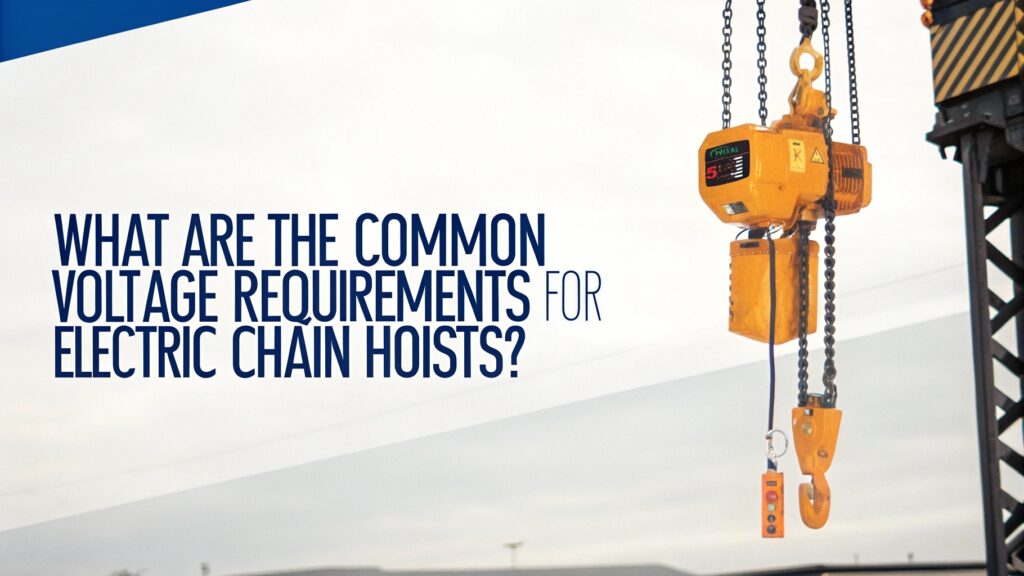Choosing the right voltage for an electric chain hoist can be confusing, especially when different voltages are common across regions and industries. Understanding the voltage requirements ensures efficiency and safety. Let’s explore the best options for your specific needs.
Electric chain hoists typically use 220V, 380V, or 400V configurations. The voltage you choose depends on the load capacity, with lighter loads often requiring 220V and heavier operations needing 380V or 400V. Always match the voltage to your operational needs to ensure safety and performance.
Now that you know the basic voltage options, let’s dive deeper into how to choose the right one for your specific operations and regional requirements. This will help guide your decision on the best hoist for your needs.
What Voltage Should You Choose for an Electric Chain Hoist?
Choosing the correct voltage for your hoist might seem overwhelming, but it’s essential for ensuring safe and efficient lifting. Let’s look into why the voltage matters so much.
The voltage choice impacts the lifting capacity and the efficiency of the hoist. For lighter tasks, 220V is usually sufficient. For heavier applications, higher voltages like 380V or 400V are necessary to handle the increased load safely.
Why the Voltage Matters in Electric Hoists
Choosing the correct voltage depends on several factors including the load, the environment, and the electrical infrastructure in your area. Lighter-duty operations often rely on 220V for efficiency, but when it comes to more intensive tasks, hoists that require 380V or 400V are more appropriate. These higher voltages ensure that the hoist can handle the heavier loads and lift them without overloading the system.
What Are the Different Types of Electric Chain Hoists Based on Voltage?
Electric chain hoists are available in a range of voltages depending on the application. Let’s take a closer look at the different types.
Electric chain hoists are often available in voltages like 220V, 380V, and 400V, each suited for different applications. 220V hoists are typically used for lighter loads, while 380V and 400V options are chosen for more demanding tasks.
Different Voltages for Different Applications
| Voltage | Applications | Load Capacity |
|---|---|---|
| 220V | Light-duty tasks | Up to 2 tons |
| 380V | Medium-duty tasks | 2 – 10 tons |
| 400V | Heavy-duty tasks | 10 tons and above |
Factors to Consider When Choosing a Voltage
Voltage is not the only factor to consider. The weight of the loads, the frequency of use, and the environment (e.g., outdoor, hazardous locations) all play a role in determining the right hoist for the job. Choosing the appropriate voltage ensures that your hoist works efficiently and within safe limits.
How Do Regional Differences Affect Hoist Voltage Choices?
Regional electrical standards can greatly influence your hoist voltage choices. Different countries and regions use different voltage standards, so it’s important to understand the options available in your area.
Regions with higher standard voltages like 380V and 400V are more likely to require heavier-duty hoists. Conversely, regions with lower voltage systems like 220V are often better suited for lighter operations. Always ensure your hoist is compatible with local electrical systems.
Regional Voltage Comparison Chart
| Region | Voltage Standard | Common Applications |
|---|---|---|
| North America | 220V – 240V | Light and medium-duty applications |
| Europe | 380V – 400V | Heavy-duty applications |
| Asia | 220V | Light and medium-duty applications |
What Safety Considerations Should You Keep in Mind When Choosing Voltage?
Voltage selection goes beyond just load capacity—it’s also about safety. Make sure your electrical infrastructure supports the voltage you plan to use, and always prioritize the safety of your team and equipment.
Choosing the right voltage ensures your hoist operates within safe limits. Over-voltage can lead to equipment failure, while under-voltage can result in inefficiency or even accidents.
Safety Measures for Hoist Voltage Selection
Check for compliance with local electrical safety standards, and consult with experts if you’re unsure about the voltage capacity of your hoist. Implement safety checks, such as regular maintenance and testing, to ensure that your equipment is in optimal working condition.
Conclusion
Understanding and selecting the right voltage for your electric chain hoist ensures safe, efficient, and reliable operation. Always align voltage selection with the specific needs of your task, regional standards, and safety guidelines.



